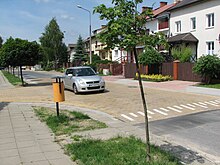Paving
Pavements are structural measures to calm traffic . This involves raising the carriageway almost to the level of the sidewalk (8 to 10 cm). It can be arranged either on a straight stretch or in the intersection or junction area. The length of the paving is designed differently, but is not less than 5 meters, as otherwise there is a risk that vehicles with little ground clearance will touch down and be damaged as a result. The ramps are designed with an incline of 1:10 to 1: 5 and are visually clearly marked (lane marking or conspicuous pavement).
There are three different types of paving:
- Partial paving over the entire width of the road
- Plateau paving with lateral spacing
- Split plateau paving with space in between
Paved pavements are effective in terms of driving dynamics and optics and thus achieve a slowdown in driving speed. For pedestrians, there is also a comfortable crossing point with no height difference with the help of paving. The reduced driving comfort for traffic (especially buses, ambulance vehicles and cyclists) and the increased noise development in the area of paving are criticized. Because of these negative aspects, paving is not installed in main traffic and collection roads , but only in residential and access roads with less traffic.
Norms and standards
- Germany
- Leaflet on structural measures to calm traffic
- Switzerland
- SN 640 213 Design of the street space; Traffic calming elements
literature
- Frank Höfler: Transport Practice, Volume 1: Transport Planning . Bauwerk Verlag, Berlin 2004, ISBN 3-934369-52-9 , p. 228 ff .

